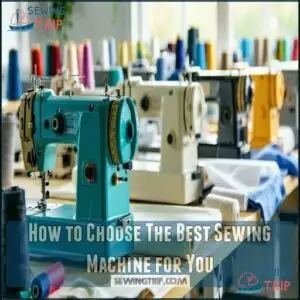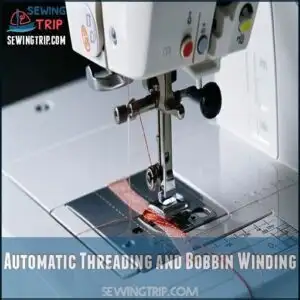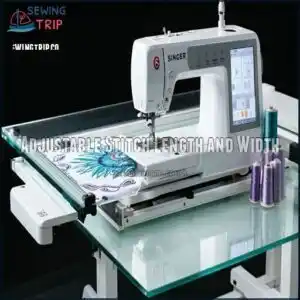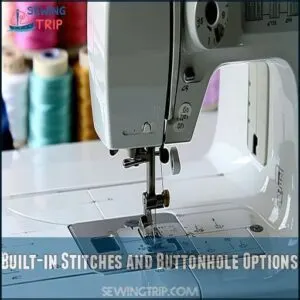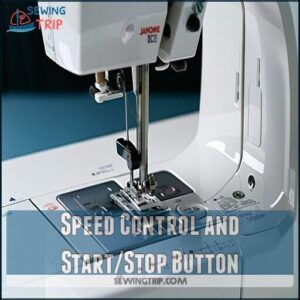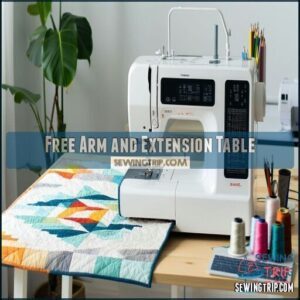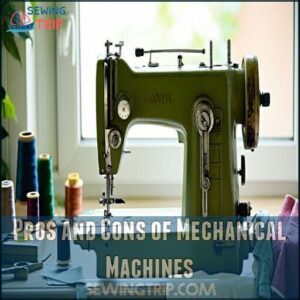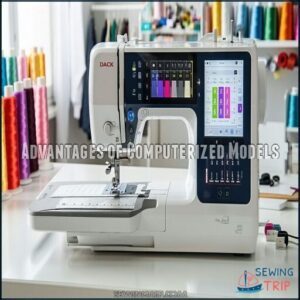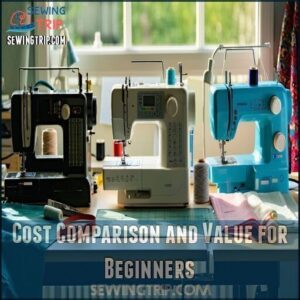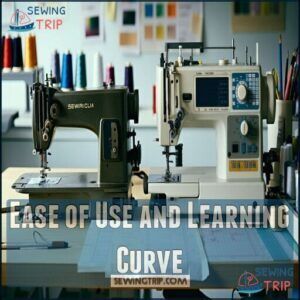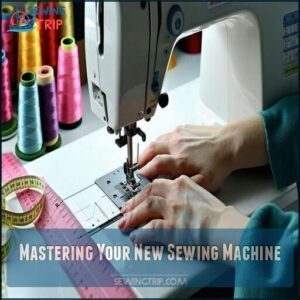This site is supported by our readers. We may earn a commission, at no cost to you, if you purchase through links.
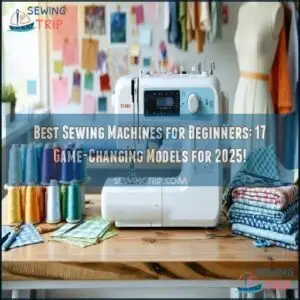 Choosing the best sewing machine for beginners means finding one that’s easy to use but still versatile enough to grow with your skills.
Choosing the best sewing machine for beginners means finding one that’s easy to use but still versatile enough to grow with your skills.
Models like the Singer M1000 or Brother CP2160L are great options thanks to features like automatic threading, adjustable stitch length, and built-in stitches for variety.
Look for extras like speed control and a free arm for sewing tricky areas like sleeves.
Mechanical machines are simple and durable, while computerized ones offer more advanced features.
Think about your projects and budget before deciding, and remember a reliable starter machine sets the stage for creativity—you’ll be stitching like a pro in no time!
Table Of Contents
- Key Takeaways
- Top 17 Sewing Machines for Beginners
- 1. Singer M1000 Sewing Machine
- 2. Brother CP2160L Sewing Machine
- 3. Janome MOD 50 Computerized Sewing Machine
- 4. Bernette 35 Swiss Design Sewing Machine
- 5. Mini Sewing Machine for Beginners
- 6. NEX Sewing Machine for Kids
- 7. Brother CS7000X Sewing and Quilting Machine
- 8. Janome Blue Couture Sewing Machine
- 9. Sewing Machine LED Light Strip
- 10. Mini Electric Sewing Machine Kit
- 11. Portable sewing machine for quilting
- 12. Singer patchwork quilting sewing machine
- 13. Brother computerized sewing quilting machine
- 14. Brother Sewing and Embroidery Machine
- 15. Portable Mini Sewing Machine Pink
- 16. Singer Heavy Duty Sewing Machine
- 17. Brother Strong and Tough Sewing Machine
- How to Choose The Best Sewing Machine for You
- Essential Features Every Beginner Should Look For
- Mechanical Vs. Computerized Sewing Machines
- Mastering Your New Sewing Machine
- Frequently Asked Questions (FAQs)
- Conclusion
Key Takeaways
- Look for features like automatic threading, adjustable stitches, and speed control. These make sewing easier and less frustrating for beginners.
- Choose a machine that fits your budget and skill level. Models around $100–$300 offer the best value without overwhelming you with advanced features.
- Mechanical machines are simple and durable, while computerized models provide precision and convenience. Pick one based on your goals and comfort level.
- Lightweight and portable designs are ideal for beginners with limited space or who want to take their machine to classes or sewing circles.
Top 17 Sewing Machines for Beginners
You’ll find the perfect balance of functionality and user-friendly features in our carefully selected lineup of beginner-friendly sewing machines, from Brother’s versatile CS7000X to Singer’s portable M1000.
These 17 machines offer everything you need to start your sewing journey without overwhelming you with complicated controls or breaking your budget, providing a perfect balance of features and affordability, making them ideal for beginners to start their sewing journey.
1. Singer M1000 Sewing Machine
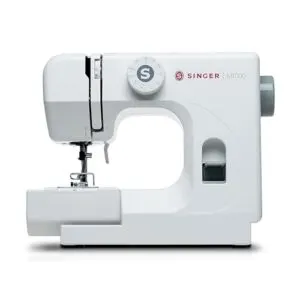
Looking for your first sewing machine? The Singer M1000 strikes the perfect balance of portability and functionality. At just 5.5 pounds, you can easily move it between rooms or take it to classes.
The Singer M1000 is lightweight, portable, and perfect for beginners—ideal for small projects and learning the ropes with ease.
What makes this machine beginner-friendly is its intuitive dial for selecting among 32 stitch applications and simple threading guides that eliminate frustration. The transparent bobbin cover lets you monitor thread supply while you work.
While not powerful enough for heavy upholstery or denim projects, it handles lightweight fabrics beautifully. The built-in finger guard adds safety as you learn.
Perfect for mending and small projects before investing in pricier models.
Best For: Beginners or casual sewists looking for a lightweight, portable machine suitable for small sewing projects and mending.
- Lightweight and portable at just 5.5 pounds
- Beginner-friendly with easy stitch selection and threading guides
- Transparent bobbin cover for convenient thread monitoring
- Not suitable for heavy fabrics like upholstery or denim
- Limited to 32 stitch applications compared to advanced models
- Lacks advanced features for experienced sewists
2. Brother CP2160L Sewing Machine
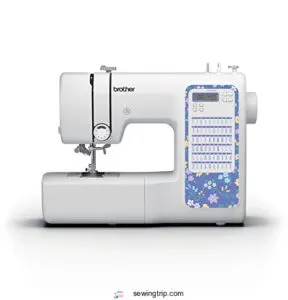
The Brother CP2160L stands out with its 60 built-in stitches and seven auto-size buttonholes, making it ideal for beginners ready to explore.
You’ll love the durable metal frame that guarantees stability while tackling denim or quilts. Its improved 2-step automatic needle threader eliminates frustration, while the bright LED workspace illuminates every detail of your project.
With a generous needle-to-arm workspace and Quick-Set bobbin system, you’ll smoothly switch between projects. The machine comes with seven specialized feet including zigzag, buttonhole, and monogramming options.
At 11.68 pounds, it’s portable yet powerful, delivering up to 1,100 stitches per minute—perfect for growing your skills.
Best For: Beginners and experienced sewists looking for a lightweight, versatile sewing machine that handles various fabrics, including heavy ones like denim.
- 60 built-in stitches and 7 auto-size buttonholes for creative flexibility.
- Portable design at only 11.68 pounds, with a durable metal frame for stability.
- High performance with up to 1,100 stitches per minute and a bright LED-lit workspace.
- Limited to use in the US at 120 volts, voiding warranty otherwise.
- 1-year limited warranty may feel short for some users.
- Lacks advanced features like Wi-Fi or computerized embroidery functions.
3. Janome MOD 50 Computerized Sewing Machine
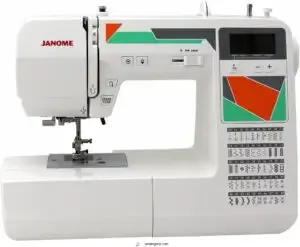
The Janome MOD 50 stands out as a perfect first machine that won’t leave you frustrated.
With 50 built-in stitches and 3 one-step buttonholes, you’ll have plenty of options without feeling overwhelmed.
The bright LCD display and intuitive navigation make adjustments straightforward, even when you’re just starting out.
You’ll appreciate the practical features like the top-loading bobbin with clear cover that lets you monitor your thread supply.
The seven-piece feed dog system guarantees your fabric moves smoothly, preventing those annoying puckers in your seams.
Its heavy-duty metal construction provides stability, while convenience features like automatic threading and thread cutting simplify the learning process.
Best For: Beginners or intermediate sewers looking for a reliable, user-friendly sewing machine with useful features and stitch variety.
- Requires careful threading to avoid issues like thread bunching.
- Limited compatibility with European power outlets without a voltage converter.
- Some users may need additional resources like tutorial videos to fully understand all features.
- 50 built-in stitches and 3 one-step buttonholes provide versatility without overwhelming new users.
- Intuitive LCD display and navigation keys make operation easy.
- Heavy-duty metal construction ensures durability and smooth performance.
4. Bernette 35 Swiss Design Sewing Machine
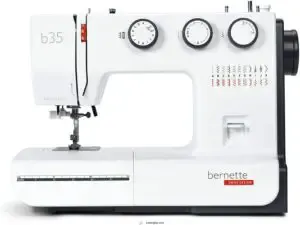
The Bernette 35 stands out as a mechanical marvel for beginners with Swiss precision engineering.
You’ll appreciate its straightforward design featuring 23 built-in stitches and seven presser feet—perfect for exploring different techniques without feeling overwhelmed.
Its lightweight construction (11.8"D x 14"W x 17.1"H) makes it portable while maintaining stability during projects.
The 2-step presser foot lift handles thick fabrics with ease, while intuitive knobs adjust stitch width, length, and pattern selection.
Though setup requires careful reading of the included handbook, and the machine can be louder when tackling multiple fabric layers, its consistent stitching and automatic buttonhole function make it a reliable companion for your sewing journey.
Best For: Beginners seeking an affordable, user-friendly sewing machine with versatile features and reliable performance.
- Setup process requires careful reading of the handbook.
- Can be loud when sewing thick fabric layers.
- Awkward placement of foot-lifting switch.
- Adjustable stitch settings for customization.
- Lightweight and portable design.
- Includes seven presser feet for various sewing techniques.
5. Mini Sewing Machine for Beginners
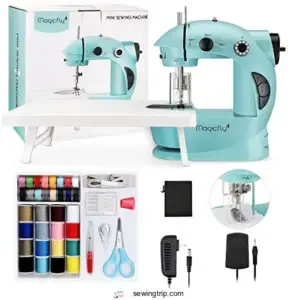
A mini sewing machine offers beginners a portable, budget-friendly entry point into the sewing world. This compact option supports both AC/DC power and battery operation with dual-speed functionality, making it perfect for quick, on-the-go projects.
With its lightweight design (8.3" height, 7.7" length), you’ll appreciate how easily it fits in small spaces. The included accessories—bobbins, needles, scissors, threader, and extension table—provide everything you need to start.
While it handles basic straight stitches and can sew through up to six layers of T-shirt material, you’ll find the single stitch type limiting as your skills advance. Perfect for simple alterations and learning fundamentals.
Best For: Beginners looking for an affordable, portable sewing machine for basic projects and simple alterations.
- Compact and lightweight design for easy storage and portability.
- Dual-power source (AC/DC or batteries) for flexibility.
- Includes a variety of beginner-friendly accessories.
- Limited to one fixed stitch type, which may restrict advanced projects.
- Tension adjustment can be finicky for some users.
- Not suitable for thick or heavy fabrics.
6. NEX Sewing Machine for Kids
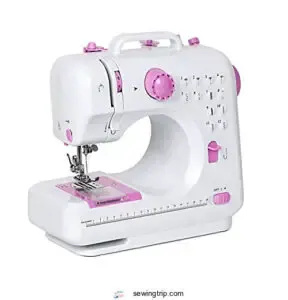
For young crafters taking their first steps into sewing, the NEX Portable Sewing Machine offers a perfect introduction.
This pink, compact machine (10.6 x 4.7 x 9 inches) features 12 built-in stitch patterns and dual power options—DC 6V or battery—making it versatile for various learning environments.
You’ll appreciate its lightweight design for easy transport between projects, while the included foot pedal and workspace light bulb help develop proper technique.
Though primarily plastic construction means it’s not suitable for thick fabrics, it excels at basic projects and alterations.
The machine includes helpful accessories like bobbins and scissors, though some users note the instruction manual could be more thorough.
NEX provides free technical support via email for any questions you might encounter.
Best For: Beginners, kids, or hobbyists looking for a lightweight and portable sewing machine for basic projects and crafting.
- Limited capability with thick fabrics or heavy-duty projects.
- Instruction manual lacks detail and clarity.
- Plastic construction may affect long-term durability.
- Compact and lightweight design for easy transport.
- Offers 12 built-in stitch patterns and a reverse function.
- Versatile power options with DC 6V or battery operation.
7. Brother CS7000X Sewing and Quilting Machine
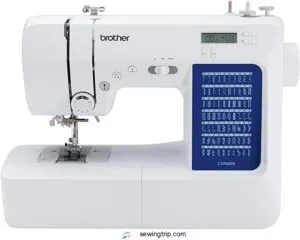
The Brother CS7000X sewing and quilting machine offers an impressive array of 70 built-in stitches, making it a fantastic choice for beginners venturing into quilting territory.
You’ll appreciate the improved automatic needle threader and seven one-step buttonholes that simplify complex projects.
With its durable metal frame construction and fixed needle bar for stability, this machine stands ready for years of creative exploration.
The generous needle-to-arm workspace provides ample room for larger projects, while the included wide table, 10 sewing feet, and protective hard case add tremendous value.
Remember that it operates on US voltage (120V) only—using it internationally will void your warranty.
Best For: Beginners and hobbyists looking for a reliable, versatile sewing and quilting machine with beginner-friendly features.
- Operates only on US voltage (120V), limiting international use.
- Warranty is void if used outside the USA.
- Free arm workspace may feel small for certain tight, intricate projects.
- Durable metal frame ensures long-lasting performance.
- Includes 70 built-in stitches and 7 one-step buttonholes for versatility.
- Wide table and included accessories enhance convenience and project options.
8. Janome Blue Couture Sewing Machine
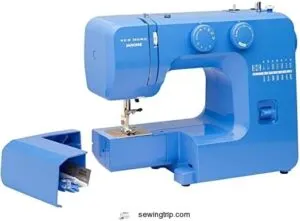
The Janome Blue Couture stands out as a beginner-friendly powerhouse with its perfect balance of functionality and ease of use.
You’ll appreciate the 70 built-in stitches, including decorative patterns and a convenient 1-step buttonhole feature.
With a maximum speed of 750 stitches per minute and intuitive speed control dial, you can confidently tackle projects at your own pace.
The sleek metal exterior doesn’t just look professional—it guarantees durability for years of use.
Setting up is straightforward thanks to the large bobbin and built-in needle threader that eliminates squinting and frustration.
The color LCD display makes stitch selection effortless, even for first-time sewers.
Whether you’re hemming pants or creating decorative pillowcases, this machine’s lightweight, portable design means you can sew wherever inspiration strikes—from crafting corner to kitchen table.
Best For: Beginners and hobbyists looking for an easy-to-use, portable sewing machine with advanced features.
- Includes 70 built-in stitches with convenient 1-step buttonhole.
- Lightweight and portable design with a durable metal exterior.
- User-friendly features like a color LCD display and built-in needle threader.
- Not ideal for heavy-duty sewing projects.
- Limited to a maximum speed of 750 stitches per minute.
- May lack advanced features for professional-grade tasks.
9. Sewing Machine LED Light Strip
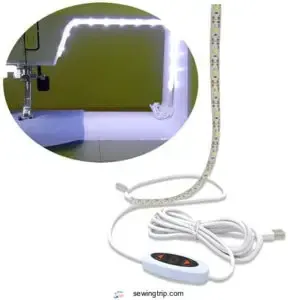
Why struggle with poor visibility when the Sew Bright LED Light Strip can illuminate your entire workspace?
This 12-inch strip features 24 LED chips that cast dimmable, shadow-free light directly onto your project.
You’ll appreciate how the subtle blue-purple hues reduce eyestrain during detailed work.
Installation couldn’t be simpler—attach it with the included adhesive strips to any sewing or quilting machine.
The USB-powered design means you can sew anytime, day or night.
Need a custom fit? Simply cut the strip at the marked locations to match your machine’s dimensions.
Say goodbye to squinting and hello to precision stitching.
Best For: Sewing and quilting enthusiasts who need improved visibility and precision for detailed work.
- Dimmable, shadow-free LED lighting enhances visibility.
- Easy installation with adhesive strips and a USB power option.
- Resizable design fits various sewing and quilting machines.
- Adhesive strips may require supplemental support.
- Some users report the switch is difficult to use.
- Subtle blue-purple light may not appeal to everyone.
10. Mini Electric Sewing Machine Kit
![Best Sewing Machines for Beginners: 17 Game-Changing Models for 2025! 10 KPCB Sewing Machine [Full Set]](https://sewingtrip.com/wp-content/uploads/2024/03/kpcb-sewing-machine-full-set-b0bqj9crgp-293x300.jpg.webp)
Despite its tiny footprint, this Mini Electric Sewing Machine Kit delivers impressive functionality for beginners.
The double-thread design tackles up to 5 layers of fabric, making it surprisingly capable for its compact size (8.6 x 6.9 x 3.5 inches).
You’ll find the built-in light, thread cutter, and rewinding pole especially convenient for precision work.
Power options include both a certified adapter and 4 AA batteries for sewing anywhere.
The extensive 42-piece kit includes essentials like bobbins, scissors, and a needle threader to jumpstart your projects.
The included extension table and foot controller enhance usability, while multilingual manuals guarantee you’ll understand setup regardless of your language preference.
Perfect for beginners seeking portability without sacrificing core features.
Best For: Beginners and hobbyists looking for a portable, affordable sewing machine with essential features.
- Compact and lightweight for easy portability.
- Includes a 42-piece sewing kit with essential tools.
- Offers both AC adapter and battery power options.
- Reports of quality issues and malfunctions after limited use.
- Manual thread setup can be challenging for some users.
- Limited capability for fixing issues after disassembly.
11. Portable sewing machine for quilting
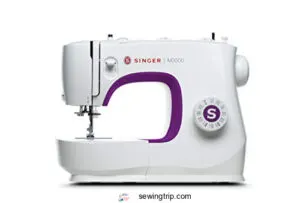
Several portable quilting machines offer the perfect balance of mobility and functionality for your creative projects.
The Brother CS7000X weighs just 10.5 pounds, making it easy to transport while delivering 70 built-in stitches and specialized quilting features. You’ll appreciate its drop-in bobbin system and included extension table for larger projects.
For ultimate portability, consider lightweight options like the Singer M1000 at only 5.5 pounds, ideal for quilting classes or sewing circles.
Look for machines with adjustable stitch length, specialized quilting feet, and speed control to handle various fabric thicknesses.
The best portable quilting machines combine convenience without sacrificing essential features.
Best For: Beginners and experienced sewers looking for a lightweight, portable sewing machine with versatile quilting and stitching features.
- Potential for thread jamming issues.
- Initial setup may be confusing for some users.
- Requires additional guidance for troubleshooting repairs.
- Lightweight and easy to transport.
- Versatile with adjustable stitch length and quilting features.
- Smooth and quiet operation, suitable for various fabrics.
12. Singer patchwork quilting sewing machine
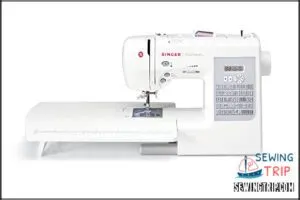
The Singer 7285Q patchwork quilting machine transforms beginners into quilting enthusiasts with its impressive feature set.
You’ll enjoy 100 built-in stitches, including 15 specialized quilting options and 61 decorative patterns to elevate your projects.
The automatic needle threader saves your eyesight, while the programmable needle up/down function makes intricate quilting maneuvers smooth and precise.
Work at your own pace using the electronic speed control, with or without the foot pedal.
The included extension table gives you ample workspace for larger quilts.
Note that it’s designed for 110V (US/Canada), and some quilters find the throat space limiting for queen-sized projects, which can be a consideration for those working on larger quilting projects with specific size requirements.
Best For: Beginners and quilting enthusiasts seeking a versatile machine with quilting-specific features and easy operation.
- Limited throat space may not accommodate larger quilts like queen-sized projects.
- Operates only at 110 volts, limiting use to specified regions.
- Warranty coverage excludes regions beyond the US and Canada.
- 100 built-in stitches, including 15 quilting stitches and 61 decorative patterns.
- Automatic needle threader and programmable needle up/down function for precision.
- Electronic speed control and extension table for versatile sewing options.
13. Brother computerized sewing quilting machine
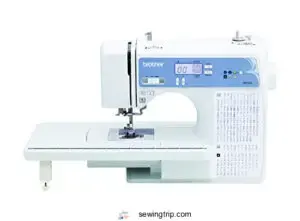
The Brother computerized sewing quilting machine stands out with its impressive 165 built-in stitches, including 110 utility and decorative options plus 55 alphanumeric stitches.
You’ll find the LCD screen intuitive for selecting your perfect stitch, while the jam-resistant drop-in bobbin system keeps your projects flowing smoothly.
The machine comes fully equipped with eight specialized feet—from zigzag to quilting—plus a wide table for larger projects and a protective hard cover for storage.
Its free arm capability makes sewing sleeves and cuffs a breeze.
While some users mention the self-threading needle function can be unreliable, Brother’s 25-year limited warranty and lifetime technical support guarantee you’re never left struggling.
Perfect for both beginners and experienced sewists who want computerized convenience without overwhelming complexity, with the assurance of a reliable protective hard cover for storage.
Best For: Sewing enthusiasts, both beginners and experienced, who want a reliable computerized sewing machine with versatile features for quilting, crafting, and everyday sewing.
- 165 built-in stitches, including utility, decorative, and alphanumeric options for creative flexibility.
- Jam-resistant drop-in bobbin system ensures smooth and hassle-free sewing.
- Comes with a wide table, protective hard cover, and multiple presser feet for various projects.
- Self-threading needle function is unreliable for some users.
- Threading mechanism can be challenging to use, especially for beginners.
- Designed for use only in the US with 120 volts.
14. Brother Sewing and Embroidery Machine
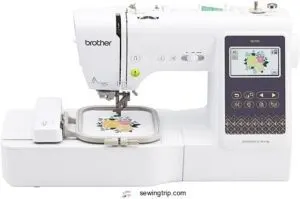
If you’re looking to expand your crafting horizons, the Brother SE700 offers dual functionality as both a sewing and embroidery machine.
You’ll get incredible value with 135 built-in embroidery designs and 103 sewing stitches at your fingertips. The user-friendly 3.7" touchscreen makes design editing intuitive, while wireless connectivity allows you to transfer custom patterns with ease.
Beginners will appreciate practical features like the automatic needle threader and 10 one-step buttonhole styles that simplify complex tasks.
The generous 4" x 4" embroidery field provides ample space for creative projects.
While some users mention occasional connectivity issues with the companion app, the machine’s versatility and strong feature set make it worth considering, offering incredible value and a user-friendly experience.
Best For: Hobbyists and beginners looking for a versatile sewing and embroidery machine with advanced features and user-friendly design.
- Limited 4" x 4" embroidery field size.
- Occasional connectivity issues with the companion app.
- Warranty restricted to U.S. use only.
- Dual functionality for both sewing and embroidery.
- Wireless connectivity for easy file transfers.
- Automatic needle threader simplifies setup.
15. Portable Mini Sewing Machine Pink
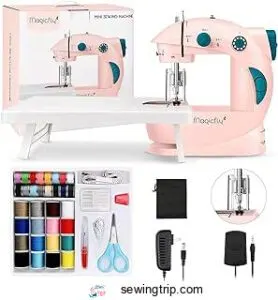
This compact pink mini sewing machine packs a punch for beginners despite its small footprint.
You’ll enjoy the versatility of dual-speed functionality and convenient dual power options – either plug it in or use batteries when you’re on the go.
The machine comes pre-threaded with essential accessories including bobbins, needles, scissors, and a storage bag for easy transport.
Its lightweight design (just 2.2 pounds) makes it perfect for quick fixes and simple projects.
While ideal for basic sewing needs, be aware of potential tension adjustment challenges.
The built-in LED lamp helps illuminate your workspace, though it’s not exceptionally bright for detailed work.
Best For: Beginners looking for a lightweight, portable sewing machine for basic sewing tasks.
- Compact and lightweight design for easy transport and storage.
- Dual power options for versatility.
- Comes with essential accessories and pre-threaded for convenience.
- Limited to basic sewing functions with no reverse or advanced stitch options.
- Potential tension adjustment challenges for some users.
- LED lamp is not very bright for detailed work.
16. Singer Heavy Duty Sewing Machine
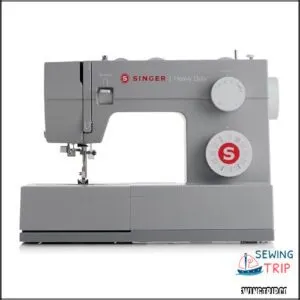
Power through any project with the Singer Heavy Duty Sewing Machine, a true workhorse featuring 110 stitch applications and impressive piercing power for multiple fabric layers.
A durable workhorse with 110 stitch options, perfect for tackling thick fabrics and creating professional-quality projects.
You’ll never struggle with thread jams thanks to the top drop-in bobbin with clear visibility cover.
Built to last, this machine boasts a full metal frame that provides exceptional stability while handling everything from delicate silks to thick denim.
The one-step buttonhole feature guarantees professional-looking results every time.
Setting up is a breeze with the built-in needle threader that saves your eyesight and patience.
These machines also have adjustable presser foot to accommodate various fabrics.
The extensive accessory package includes six specialized presser feet to tackle various sewing techniques.
Maintenance couldn’t be simpler—just perform basic cleaning and oiling after completing projects for years of reliable service.
Best For: Beginners and experienced sewists who need a durable, high-performance sewing machine for heavy-duty fabrics and diverse projects.
- Handles thick fabrics like denim and canvas with ease.
- Built-in needle threader and top drop-in bobbin for convenience.
- Durable full metal frame ensures stability and long-term use.
- Noisy operation, especially with heavy fabrics.
- Some users find presser foot attachment tricky.
- Lacks advanced features like needle down functionality and automatic thread cutter.
17. Brother Strong and Tough Sewing Machine
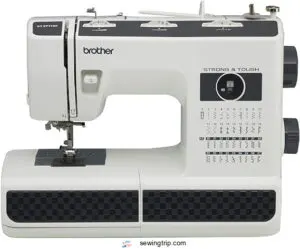
Standing tall among beginner machines, the Brother Strong and Tough ST371HD delivers exactly what its name promises.
You’ll master projects of all sizes with its heavy-duty metal frame and 37 built-in stitches. The automatic needle threader saves your eyesight, while the jam-resistant drop-in bobbin keeps frustration at bay.
Need to sew sleeves or pants? The free arm feature makes maneuvering tight spaces a breeze.
With six specialized sewing feet included, you’re ready to tackle diverse projects right out of the box. Though it runs slightly louder than other models, this workhorse powers through multiple fabric layers with confidence.
The sturdy metal needle plate guarantees smooth feeding, whether you’re working with delicate silks or heavy denim.
Best For: Beginner and intermediate sewists seeking a durable machine that can handle various projects and fabrics, including heavy materials.
- Heavy-duty metal frame ensures durability and smooth operation.
- Comes with 37 built-in stitches and six sewing feet for versatile sewing options.
- Free arm feature allows for easy sewing in tight spaces like sleeves and pants.
- Runs louder than other comparable models.
- Limited to medium-weight fabrics despite its heavy-duty construction.
- Not suitable for extremely delicate or very thick materials without adjustments.
How to Choose The Best Sewing Machine for You
You’ll need to match your sewing machine to your specific goals, whether you’re creating simple repairs or complex quilting projects.
Consider your budget, space constraints, and the manufacturer’s reputation to find a model with the right features for your needs, which aligns with your overall goals.
Assessing Your Sewing Goals and Projects
Before buying a sewing machine, take stock of your specific goals.
Are you mending worn jeans, crafting quilts, or dreaming of designing your own wardrobe?
Your project complexity, fabric choices, and time commitment will determine which features you need.
Match your skill level with the right beginner sewing machine – simpler machines work well for basic sewing skills, while versatile models support your growth into advanced garment types.
Your future sewing path matters as much as where you start.
Budget Considerations and Price Ranges
Now that you’ve identified your sewing goals, let’s talk money.
Sewing machines typically fall into three price brackets: entry-level ($100-200), mid-range ($200-500), and premium ($500+).
For beginners, budget-friendly options around $300 offer the best value, balancing essential features with affordability.
Remember, a cheap sewing machine might save money upfront but could lead to frustration and repair costs later, consider your purchase an investment—quality machines hold their value and grow with your skills.
Space and Portability Requirements
While budget sets the stage, finding the right home for your sewing machine is equally important.
Your available space directly impacts your sewing success.
- The SINGER M1000.662 measures just 9.5" x 11.5", perfect for small apartments
- Lightweight machines like the KPCB (under 3 pounds) store easily in closets
- Compact designs work well on kitchen tables for small projects
- Hard cases protect your investment during moves
- Portable sewing machines let you take your hobby to friends’ homes
Remember to keep in mind your workspace needed – you’ll need room to spread fabric while working on beginner projects, and consider the importance of portable sewing machines and having a compact design.
Brand Reputation and Customer Support
Several key factors distinguish reliable sewing machine brands from the rest.
Singer, Brother, and Janome have earned their reputation through extensive warranty options and responsive technical support.
When researching, examine sewing machine reviews for community feedback about how companies handle issues.
The best brands offer thorough online resources, including tutorials and forums.
Brand reliability matters substantially—you’ll appreciate accessible support when threading issues or tension problems inevitably arise during your sewing journey, and having responsive technical support can be crucial, as it shows the company’s commitment to helping customers resolve sewing machine issues.
Essential Features Every Beginner Should Look For
You’ll need specific features on your first sewing machine to make learning easier and projects successful.
Key elements like automatic threading, adjustable stitch settings, and speed control will substantially reduce frustration and help you create professional-looking results from day one, with professional-looking results being a key outcome of these features.
Automatic Threading and Bobbin Winding
Having chosen your machine, you’ll appreciate features that eliminate threading frustration.
Automatic threading and bobbin winding systems transform what many beginners find intimidating into simple tasks.
Modern threading mechanisms guide thread directly through the needle’s eye with just a lever push.
Meanwhile, automatic bobbin winding systems stop precisely when full, preventing jamming issues.
Many sewers find an automatic threader invaluable for their projects.
- Drop-in bobbins save tears of frustration compared to front-loading designs
- Top-loading systems let you monitor remaining thread without surprises
- Clear thread guides with arrows eliminate guesswork
- Auto-threaders save your eyesight and patience
- Consistent thread tension means fewer tangled messes underneath your fabric
Look for machines featuring both—your fingers will thank you, as automatic threading and bobbin winding systems make a significant difference, providing simple tasks and invaluable tools for sewers.
Adjustable Stitch Length and Width
For beginners, adjustable stitch length and width features are game-changers on your sewing journey. With simple dials or digital controls, you’ll gain precise command over how your stitches form and connect.
Shorter stitches (1-2mm) create stronger seams for sturdy fabrics, while longer ones (3-4mm) work better for basting or gathering. Stitch width adjustment is equally important, especially when zigzagging or creating decorative patterns.
You’ll appreciate being able to narrow stitches for reinforced seams or widen them for appliqué work. Different fabric types demand specific settings—delicate silks need shorter, narrower stitches, while denim requires longer, wider ones.
Think of these adjustments as your sewing GPS, guiding you through various projects with precision. You can find a variety of products related to adjusting stitch parameters online.
The best sewing machines for beginners include clearly marked controls that make these adjustments intuitive, letting you focus on creativity rather than struggling with settings.
Built-in Stitches and Buttonhole Options
Now that you’ve got your stitch length and width sorted, let’s talk about stitch variety – your sewing machine’s creative toolbox.
The right built-in stitches transform simple projects into professional-looking creations.
Your beginner sewing machine should offer:
- 15-30 basic stitch options including straight, zigzag, and stretch stitches for knits
- At least one automatic buttonhole style (four-step or one-step)
- A few decorative stitches to add flair to your projects
- Clear stitch selection controls that won’t leave you hunting for that perfect stitch
Quality trumps quantity – you’ll use about 5-7 stitches for 90% of your beginner projects.
Speed Control and Start/Stop Button
Speed-mastery features like intuitive control and start/stop buttons transform your beginner sewing experience.
You’ll appreciate adjustable settings when switching between projects that require different precision levels.
| Feature | Benefit | Best For |
|---|---|---|
| Foot Pedal Control | Hands-free operation | Traditional sewists |
| Start/Stop Button | No pedal needed | Multi-taskers |
| Speed Precision | Prevents runaway stitches | Learning curve reduction |
Most simple sewing machines offer these essential controls for stress-free quilting speed adjustments, allowing for precise operation.
Free Arm and Extension Table
When you’re learning to sew, a free arm and extension table are must-have features that’ll make your projects much easier.
The free arm lets you work on cylindrical items like cuffs and collars, while the extension table provides essential fabric support for larger projects. Precise stitching is a notable benefit.
- Look for table stability when selecting your beginner sewing machine – it should attach securely without wobbling
- Consider models with accessory storage built into the removable extension table
- Choose machines with generous table size for quilting benefits, giving you ample workspace
Simply remove the table for free arm uses and reattach when you need that extra support.
Mechanical Vs. Computerized Sewing Machines
You’ll need to choose between a mechanical machine with manual controls and knobs or a computerized model with digital displays and automated functions.
While mechanical machines offer straightforward operation and durability at a lower price point, computerized models provide precision stitching, memory functions, and touchscreen interfaces that can simplify your learning process.
Pros and Cons of Mechanical Machines
Now that we’ve covered essential features, let’s examine what mechanical sewing machines bring to your crafting table.
Mechanical machines offer reliability with straightforward operation that many beginners appreciate.
| Feature | Advantage | Limitation |
|---|---|---|
| Durability | Built like tanks, often lasting generations | Fewer creative options |
| Controls | Simple knobs you can feel and adjust | Manual threading required |
| Maintenance | Lower repair costs, DIY-friendly | No digital troubleshooting |
| Learning Curve | Intuitive operation, no manuals needed | Limited stitch variety |
| Price | Budget-friendly for beginners | Basic functionality only |
You’ll trade bells and whistles for dependable performance and simplicity. Their low learning curve makes them very accessible, offering a low learning curve for new users.
Advantages of Computerized Models
Computerized sewing machines bring buttons and screens to your fingertips, revolutionizing the beginner’s journey.
These digital powerhouses offer advantages that make learning smoother and projects more professional.
The user-friendly interface guides you through each step, while automatic features handle technical details.
You’ll enjoy embroidery options that mechanical models simply can’t match.
| Feature | Benefit |
|---|---|
| Stitch Customization | Create unique designs beyond basic options |
| Automated Features | Threading and buttonholes with one touch |
| Precision Control | Consistent speed regardless of foot pressure |
| Pattern Memory | Save favorite settings for future projects |
The advantages of these machines include features like stitch customization, which allows for unique designs beyond basic options, making the sewing experience more enjoyable and user-friendly.
Cost Comparison and Value for Beginners
While computerized models offer fancy extras, let’s talk wallet impact.
Your initial investment varies substantially between machine types, with mechanical options providing fantastic value for beginners.
| Feature | Mechanical | Computerized | Budget Models |
|---|---|---|---|
| Price Range | $100-200 | $300-600 | $50-100 |
| Long-Term Costs | Lower repairs | Higher maintenance | Replacement likely |
| Feature Value | Basic, reliable | Advanced, numerous | Limited, basic |
| Brand Value | High durability | Tech advantages | Variable quality |
| Resale Value | Maintains well | Depreciates faster | Minimal return |
Ease of Use and Learning Curve
Beyond cost considerations, the way you’ll interact with your machine affects your learning journey.
The way you interact with your machine can be broadly categorized into two types: mechanical and computerized, which have distinct features as shown below:
| Feature | Mechanical | Computerized |
|---|---|---|
| Threading Difficulty | Manual with diagrams | Guided with auto-threading |
| Stitch Selection | Simple dial turns | Touch buttons or screen |
| Speed Control | Foot pedal pressure | Adjustable settings |
Computerized models offer user-friendly error messages and built-in tutorials, while mechanical machines encourage hands-on learning. Most beginner sewing machines balance usability with enough features to grow your skills without overwhelming you.
Mastering Your New Sewing Machine
You’ll transform from confused novice to confident creator as you master your machine’s essential functions, from proper threading to stitch selection.
With consistent practice and patience, you’ll quickly learn to troubleshoot common issues while developing the muscle memory needed for precise, professional-looking projects, and this will lead to precise results.
Setting Up and Threading Your Machine
Before stitching anything, set up your beginner sewing machine on a stable surface. Check your needle insertion—it should be secure and straight.
Follow your manual’s threading guide to run the thread through tension discs and the take-up lever, ensuring proper thread tension.
For bobbin winding, fill it evenly, then load it into the case until it clicks. Attach your presser feet correctly, depending on your project.
Test everything using scrap fabric before taking your first stitch. Remember to securely place thread on the spool pin before beginning. Threading gets easier with practice, so don’t rush and ensure you have proper thread in place.
Understanding Different Stitches and Their Uses
Your sewing machine stitches are your toolkit.
The straight stitch is your go-to for seams.
Zigzag stitches keep edges from fraying, while the blind hem creates discreet hems for a polished look.
For closures, master buttonhole techniques with ease.
Stretch stitch uses are vital for knit fabrics, while decorative stitching enhances projects.
Stitch applications reveal endless beginner sewing possibilities—explore your options!
Practicing Basic Sewing Techniques
Let’s put those stitches to work! Grab your beginner sewing machine and start with straight stitching on scrap fabric.
Practice controlling seam allowances and fabric handling as you go. Try beginner projects like simple tote bags or pillowcases to learn to sew confidently.
Experiment with pivot points on corners, and use backstitching to secure your seams. Don’t shy away from different fabrics—light cotton or stretchy knits can all teach you something new.
For more practice, consider purchasing helpful tools. Remember, every stitch builds your skills!
Troubleshooting Common Issues
Your machine may face hiccups. Don’t stress—here’s how to handle them:
- **Thread Tension off?
** Re-thread with the presser foot up, ensuring smooth threading.
- **Fabric Feeding poorly?
** Check the feed dogs; lint buildup can block proper movement.
- **Bobbin Issues or Needle Problems?
** Replace damaged needles and rewind bobbins evenly to avoid uneven stitching.
Regular sewing machine maintenance keeps beginner sewing machines running smoothly!
Frequently Asked Questions (FAQs)
What is the best sewing machine for beginners?
Ever wonder which sewing machine is perfect to start your journey?
Go for the Brother CS7000X—it’s versatile, user-friendly, with 70 built-in stitches and an automatic threader to make your projects seamless and frustration-free, which makes it a great choice for beginners looking for a seamless experience.
How to choose a sewing machine for beginners?
Start by identifying your needs—consider stitch options, ease of use, and durability.
Look for features like automatic threading and adjustable speed.
A lightweight, portable model with basic stitches is ideal for honing your skills.
Which sewing machine should I buy?
You should consider the Brother CS7000X.
It’s beginner-friendly, with 70 stitches, an automatic threader, and a drop-in bobbin.
Lightweight but versatile, it’s great for learning and mastering various projects without overwhelming complexity.
What is the fastest sewing machine?
The SINGER 4423 Heavy Duty Sewing Machine is one of the fastest, capable of 1,100 stitches per minute.
It’s perfect if you want speed without sacrificing precision for projects needing quick turnaround times.
What type of sewing machine is best for beginners?
Go for a mechanical sewing machine if you’re just starting out.
They’re easier to use, affordable, and durable.
Look for features like built-in stitches, automatic threading, and adjustable speed for more control and confidence.
Is Brother or Singer a better sewing machine?
Choosing between Brother and Singer is like picking a tool for a specific craft.
Brother excels in user-friendly features and affordability, while Singer offers durability.
It depends on your sewing needs and long-term goals.
How much should a beginner spend on a sewing machine?
You should budget between $100 and $300 for a beginner sewing machine.
This price range guarantees quality features like adjustable stitches, a drop-in bobbin, and automatic threading, without overpaying for advanced options you won’t use yet.
What is the most trouble-free sewing machine?
Reliable, robust, and ready-to-go, the Brother CS7000X shines as the most trouble-free sewing machine.
With an automatic needle threader, drop-in bobbin, and customizable speed, it helps you sew smoothly without stress or snags.
Which type of sewing machine is best for a beginner?
Go for a mechanical sewing machine if you’re starting out—it’s simple, durable, and easier to learn.
Models like the Brother XM2701 or Singer Tradition 2277 provide essential features without overwhelming you.
Can a beginner use a computerized sewing machine?
Beginners can use computerized sewing machines.
They simplify sewing with automatic features like needle threading and stitch selection, but be patient while learning.
Start slow, explore functions, and you’ll enjoy the technology’s convenience and precision.
Conclusion
Selecting the best sewing machine for beginners means balancing ease of use, reliability, and features that support growth.
Whether you choose the Singer M1000, Brother CP2160L, or another from our list, prioritize options like automatic threading, adjustable stitches, and portability.
Start small, but make certain the machine fits your creative goals.
Remember, a versatile, beginner-friendly machine helps you master basics and tackle future projects with confidence.
With the right choice, you’ll enjoy years of sewing success!
- https://www.reddit.com/r/SewingForBeginners/comments/18s4yss/what_is_the_best_sewing_machine_for_a_total/
- https://sewcanshe.com/the-7-best-sewing-machines-for-a-beginner/
- https://www.nytimes.com/wirecutter/reviews/best-sewing-machine/
- https://www.brother-usa.com/home/sewing-embroidery/beginner-sewing-machines
- https://thecraftblogger.com/the-best-sewing-machine-for-fashion-design-students-and-new-sewists/

